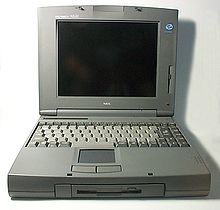PC-98
PC-98 is a name for computers based on the NEC PC-9800 . PC-98 computers were very common in Japan . The calculator was offered from 1982 to 1997.
more details
The PC-98 is partly similar to the IBM PC , but instead of the ISA bus it has the so-called C-Bus , its own 16-bit bus, which was also used in the PC-88 series from NEC . In addition, BIOS , I / O port addressing, memory management and graphics output (via NEC µPD7220 ) are different from conventional PCs.
history
The development and success of the PC-98 was based on the specifics of the Japanese market. This was largely isolated from foreign companies, so that Japanese manufacturers dominated the market. While personal computers largely prevailed in the rest of the world, the Japanese manufacturers stuck to mainframes for a long time , which was due, among other things, to problems with the support of the Japanese script.
When the IBM PC enjoyed great success in the rest of the world, Japanese manufacturers developed various incompatible PC standards. While most Japanese manufacturers only marketed PCs as terminals for their mainframes, NEC, which had the smallest market share at the time, took a different approach and developed the PC-98, a computer that could be used as a stand-alone computer. Since Microsoft was not ready to adapt MS-DOS to the PC-98, NEC also developed the operating system itself. In October 1982, the PC-9801 was the first model in the PC-98 series. NEC was able to secure a large market share, primarily because of the time advantage. A rich software library developed through clever marketing; in 1987 there were 3,500 software products for the PC-98. The first clones of the PC-98 were soon created, including the first PC-98-based laptop in 1987. In 1991, the PC-98 held a market share of 60 percent. Because NEC held the copyright to all relevant components, it was able to generate a large profit from high prices.
The decline of the PC-98 began in 1991 with the development of DOS / V . DOS / V made it possible for the first time to use the Japanese language on common IBM-compatible PCs, so that no special computers like the PC-98 had to be purchased. Windows 3.1 followed in 1993 . This was also published for the PC-98, but thanks to the common programming library, a special adaptation of application programs to the different computer architectures was no longer necessary. This meant that the PC-98 no longer had any advantages over IBM-compatible PCs and was unable to establish itself in the long term because of the high price. As a result, NEC was forced to discontinue the PC-98 series for good in 1997.
Web links
- Joel West, Jason Dedrick: Innovation and Control in Standards Architectures: The Rise and Fall of Japan's PC-98. Archived from the original on April 2, 2015. In: Information Systems Research . 11, No. 2, June 2000, pp. 197-216. Retrieved November 27, 2015.
- FreeBSD / pc98 Project (English)
Individual evidence
- ↑ NEC PC-9801 (platform). Retrieved May 10, 2020 (English).
- ↑ How the PC-98 Shaped Japan's PC Industry. In: VR World. January 27, 2015, accessed May 10, 2020 (American English).

